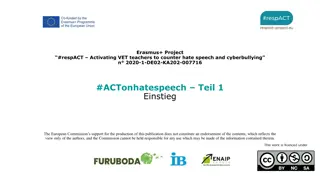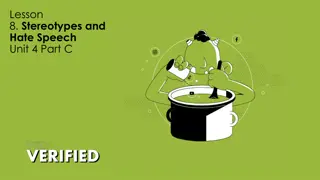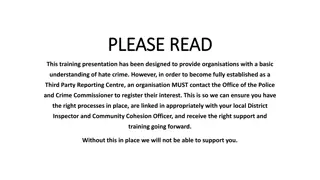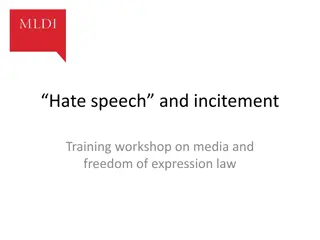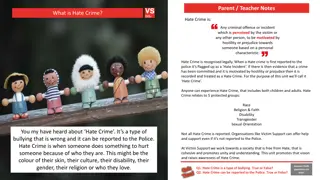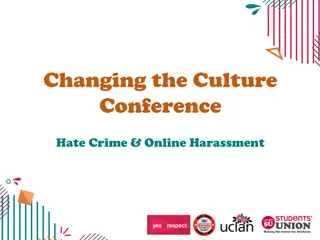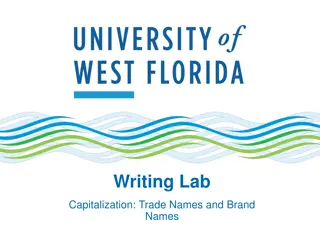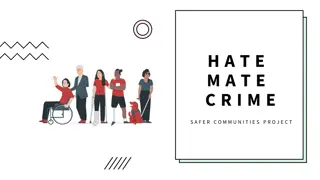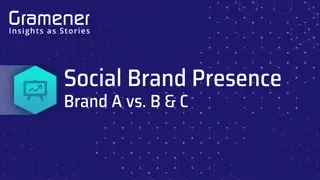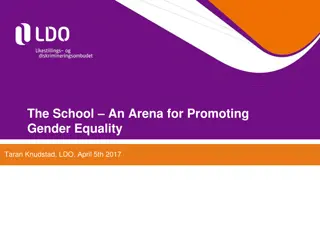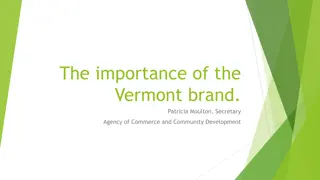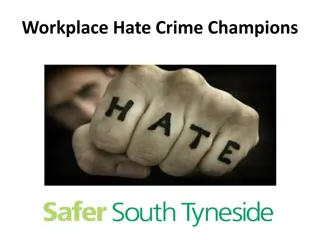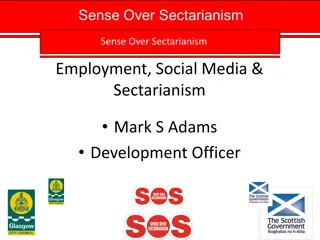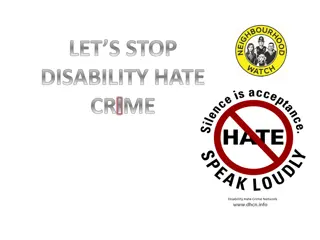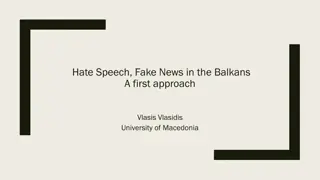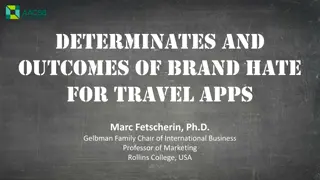Understanding Brand Hate: A Review and Agenda
Exploring the concept of brand hate as a complex emotion, this systematic literature review delves into the significance of negative emotions, particularly hate, in shaping consumer behaviors. The research highlights the scarcity of studies focusing on negative brand relationships like brand hate, offering insights into the motivations and factors influencing consumers' negative perceptions towards brands.
Download Presentation

Please find below an Image/Link to download the presentation.
The content on the website is provided AS IS for your information and personal use only. It may not be sold, licensed, or shared on other websites without obtaining consent from the author. Download presentation by click this link. If you encounter any issues during the download, it is possible that the publisher has removed the file from their server.
E N D
Presentation Transcript
Brand hate: A systematic literature review and future research agenda Abhishek Yadav (Doctoral Scholar) Indian Institute of management, Kashipur, India Dr. Somnath Chakrabarti, Ph.D. Indian Institute of management, Kashipur, India 7th International Consumer Brand Relationships Conference
Yadav, A., & Chakrabarti, S. (2022). Brand hate: A systematic literature review and future research agenda. International Journal of Consumer Studies, 00, 1 28. https://doi.org/10.1111/ijcs.12772
Conceptual Framework Future Research Introduction Review of Literature Thematic Analysis Hate Hate is a complex emotion and psychology researchers have diverse opinions about it being a primary emotion (Arnold, 1960). Even though some researchers consider it a simple emotion (Fehr and Russell, 1984; Shaver et al., 1987; Storm and Storm, 1987), majority of them think that hate is a compounded form of other primary and/or secondary emotions. Anger/Fear Anger Disgust Disgust Contempt Kemper (1987) McDougall (2001) Plutchik (1991) Sternberg (2003) Anger Anger Fear Fear Disgust 07-10-2024 3
Conceptual Framework Future Research Introduction Review of Literature Thematic Analysis Hate Hate is one of the strongest negative emotions that individuals can experience. Psychology researchers (Ito et al., 1998; Rozin and Royzman, 2001) have identified the relatively higher significance of negative emotions such as hate in shaping the behaviours of individuals in comparison to positive emotions. Therefore, decision-makers give substantial importance to understanding the negative experiences of individuals (Kanouse, 1984). Despite this, in comparison to research on positive emotions such as brand love (e.g., Albert and Merunka, 2013; Batra et al., 2012; Carroll and Ahuvia, 2006), brand attachment (e.g., Park et al., 2008; Thomson et al., 2005), and brand loyalty (e.g., Bloemer and Kasper, 1995; Chaudhuri and Holbrook, 2001), research on negative brand relationships such as brand avoidance (e.g., Lee et al., 2009; Rindell et al., 2013), anti- branding (e.g. Krishnamurthy and Kucuk, 2009; Kucuk, 2008), brand dislike (e.g. Dalli et al., 2006), and brand hate (e.g., Hegner et al., 2017; Zarantonello et al., 2016) is relatively scarce.. 07-10-2024 4
Conceptual Framework Future Research Introduction Review of Literature Thematic Analysis Brand Hate Brand hate as a construct was first conceptualized by Kucuk (2008) in academic literature in which he gave the theory of Negative Double Jeopardy to understand the motivation behind anti-branding websites. Since then, researchers have considered brand hate as Shame (Johnson et al., 2011); extreme form of dislike (Romani et al., 2012); compound of intense negative emotions (Fetscherin, 2019; Kucuk, 2016; Zarantonello et al., 2016; Zhang and Laroche, 2020) etc. Consumers can experience hatred towards a brand due to multiple internal and external factors. Experience of such hatred will define an individual s behavior towards the brand. 07-10-2024 5
Conceptual Framework Future Research Introduction Review of Literature Thematic Analysis Brand hate conceptualization First academic conceptualization of brandhate as a type of consumer-brand relationship defined it as antithetical to brand love (Caroll and Ahuvia, 2006). Anger + Disgust + Contempt Extreme negative affect Brand hate emotion Brand hate emotion Shame Unidimensional Johnson et al (2011) Hegner et al (2017) Romani et al (2015) Bryson et al (2013) Kucuk (2018) Brand hate Caroll and Ahuvia (2006) Fetscherin (2019) Zarantonello et al. (2016) K hr et al. (2016) Romani et al (2012) Multidimensional Anger Dislike Anger Sadness Worry Embarrassment Discontent Anger Frustration Outrage Hatred Anger Disgust Contempt Contempt/Disgust Fear Disappointment Shame Dehumanization 07-10-2024 6
Conceptual Framework Future Research Introduction Review of Literature Thematic Analysis Research objectives To undertake a comprehensive literature review of assiduously selected peer-reviewed articles related to the concept of brand hate to understand and define various trends, perspectives, and research streams. To explore theoretical foundations of brand hate literature to identify possible theoretical integration opportunities. To propose a holistic conceptual framework for future research defining various cause-effect relationships of antecedents and outcomes of brand hate. To determine potential future research directions that may stimulate research in this domain. 07-10-2024 7
Conceptual Framework Future Research Introduction Review of Literature Thematic Analysis Review methodology 07-10-2024 8
Conceptual Framework Future Research Introduction Review of Literature Thematic Analysis Overview Even though companies have been investing in prevention of hate development in consumers towards their brand(s) for a long time, academia s focused on this type of consumer brand relationship only by the end of 1st decade of 21st century with pioneering article of Kucuk (2008). The articles selected for review were exploratory in nature with significant focus on identification of factors leading to brand hate generation and behavioral outcomes. There is significant variation in conceptualization of brand hate construct among researchers. Brand hate researchers have taken theoretical support from 15 widely accepted theories from diverse research domains of sociology, psychology, marketing, and consumer behavior to synergize into their research frameworks. Triangular theory of hate (Sternberg, 2003) and social identity theory (Tajfel, 1974) were the most widely used theories. Research on brand hate has exploded in the past couple of years as almost 50% of the articles selected for review were published in year 2019 and 2020. 07-10-2024 9
Conceptual Framework Future Research Introduction Review of Literature Thematic Analysis Overview 07-10-2024 10
Conceptual Framework Future Research Introduction Review of Literature Thematic Analysis Overview 07-10-2024 11
Conceptual Framework Future Research Introduction Review of Literature Thematic Analysis Theoretical underpinnings 07-10-2024 12
Conceptual Framework Future Research Introduction Review of Literature Thematic Analysis Themes Brand hate Stimuli: Individual level Brand Level Environmental Brand hate emotion Brand hate behavior Active Passive 07-10-2024 13
Conceptual Framework Future Research Introduction Review of Literature Thematic Analysis Stimuli-Organism-Response (SOR) framework Researchers have considered S-O-R framework as a comprehensive tool to understand customers cognitive and affective states and their subsequent behavior due to interaction with market stimuli (Buxbaum, 2016; Mehrabian and Russell. 1974; Vieira, 2013). 07-10-2024 14
Conceptual Framework Future Research Introduction Review of Literature Thematic Analysis Stimuli-Organism-Response (SOR) framework Traditionally, S-O-R framework has been used in the context of store environment in which cues such as store lighting, color, smell etc. are considered as stimuli that influences the internal state of customers and subsequently their behavior (e.g., Eroglu et al., 2001; Koo and Ju, 2010; Mehrabian and Russell, 1974). But researchers have used S-O-R framework in other contexts as well for example, to explain buying behavior, engagement, co-creation, purchase intention and so on. Mckinney (2004) used this framework to establish a relationship between customers diverse internal motivation for online shopping and how significantly it impacts their satisfaction. Peng and Kim (2014) used this framework to assess impact of internal and environmental stimuli on repurchase intentions in online shopping context Likewise, Wu and Li (2018) explored the effects of marketing-mix components on loyalty in social commerce context using this framework where consumer value was defined as organism. 07-10-2024 15
Conceptual Framework Future Research Introduction Review of Literature Thematic Analysis Conceptual framework 07-10-2024 16
Conceptual Framework Future Research Introduction Review of Literature Thematic Analysis Future research agenda TCCM framework Theory: Psychological field theory (Lewin, 1939) Balance theory (Heider, 1958) Personality traits OCEAN model Context: Market Less prestigious brands Demography Cross cultural setting Industry specific Characteristics: Lack of bipolarity in love-hate relationship Distinction of stimuli for different hate levels Method: Mixed-method approach Machine learning-based analytical tools Non-consumer haters 07-10-2024 17
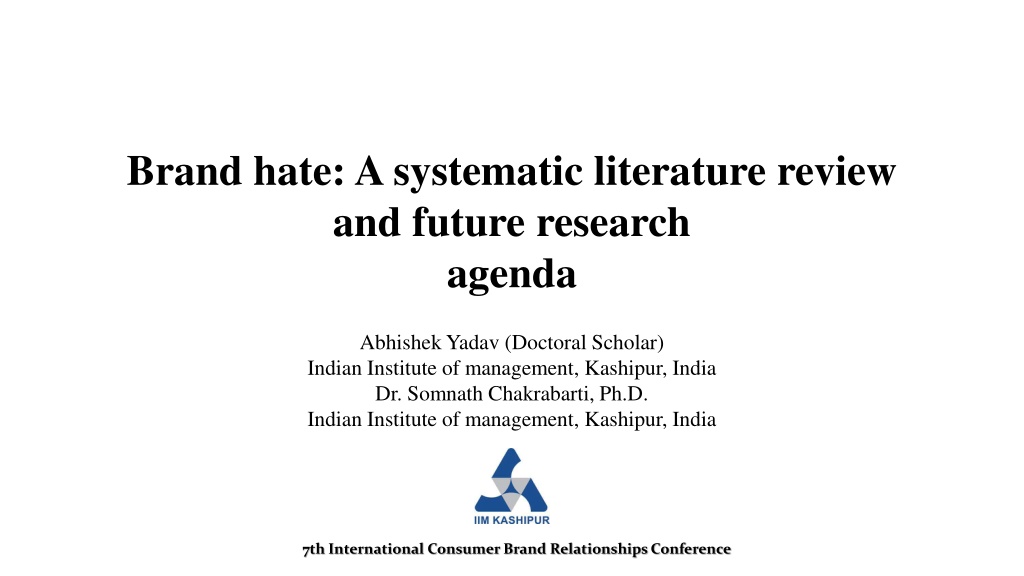

![Prevention and Combating of Hate Crimes and Hate Speech Bill [B.9B.2018]](/thumb/60513/prevention-and-combating-of-hate-crimes-and-hate-speech-bill-b-9b-2018.jpg)
